Anton Haeckl was a musical instrument builder in Vienna, who built the first physharmonica in 1818. Two of his instruments from 1825 (refs. Inv. Nr. 19.480 (20 white keys) and Inv. Nr. 38.956) can be seen in the Vienna Technical Museum.
The physharmonica looked similar to the hand harmonium still in use in India today, with a piano-style keyboard. Smaller examples of this type of instrument rested on the left arm, and were played with the right hand. The range of notes was from B to g".
A newspaper advert of 14 April 1821 in the "Allgemeine Musikalische Zeitung" says: "The master also makes very small versions which rest comfortably on the left arm, and which the right hand plays." [1]
A patent ("privilegium") was granted to Anton Haeckl for such instruments on 8 April 1821.
Similar early instruments, built in France, looked somewhat like an oversized modern piano-accordion, but were placed, like pianos, on a stand so one could use both hands on the keyboard. The bellows were operated by foot pedals and a string mechanism. The instrument had no bass section, so though it looked like an accordion it is treated as forerunner of the harmonium.
One such instrument, made by "Busson Brevete" (Paris) in 1880, can be seen in the Vienna Technical Museum (ref. Inv. Nr. 15.289).

Accordions are a family of box-shaped musical instruments of the bellows-driven free-reed aerophone type, colloquially referred to as a squeezebox. A person who plays the accordion is called an accordionist. The concertina and bandoneón are related. The harmonium and American reed organ are in the same family, but are typically larger than an accordion and sit on a surface or the floor.

A musical keyboard is the set of adjacent depressible levers or keys on a musical instrument. Keyboards typically contain keys for playing the twelve notes of the Western musical scale, with a combination of larger, longer keys and smaller, shorter keys that repeats at the interval of an octave. Depressing a key on the keyboard makes the instrument produce sounds—either by mechanically striking a string or tine, plucking a string (harpsichord), causing air to flow through a pipe organ, striking a bell (carillon), or, on electric and electronic keyboards, completing a circuit. Since the most commonly encountered keyboard instrument is the piano, the keyboard layout is often referred to as the piano keyboard.
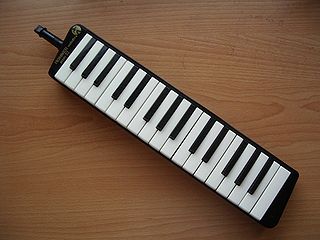
The melodica is a free-reed instrument similar to the pump organ and harmonica. It has a musical keyboard on top, and is played by blowing air through a mouthpiece that fits into a hole in the side of the instrument. Pressing a key opens a hole, allowing air to flow through a reed. The keyboard usually covers two or three octaves. Melodicas are small, light, and portable. They are popular in music education, especially in Asia.
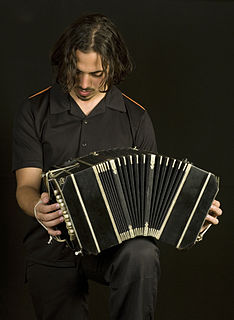
The bandoneon is a type of concertina particularly popular in Argentina and Uruguay. It is a typical instrument in most tango ensembles. As with other members of the concertina family, the bandoneon is held between both hands, and by pulling and pushing actions force air through bellows and then routing air through particular reeds as by pressing the instrument's buttons. Bandoneons have a different sound from accordions, because bandoneons do not usually have the register switches that are common on accordions. Nevertheless, the tone of the bandoneon can be changed a great deal using varied bellows pressure and overblowing, thus creating potential for expressive playing and diverse timbres.

A free reed aerophone is a musical instrument that produces sound as air flows past a vibrating reed in a frame. Air pressure is typically generated by breath or with a bellows. In the Hornbostel–Sachs system, it is number: 412.13. Free reed instruments are contrasted with non-free or enclosed reed instruments, where the timbre is fully or partially dependent on the shape of the instrument body, Hornbostel–Sachs number: 42.
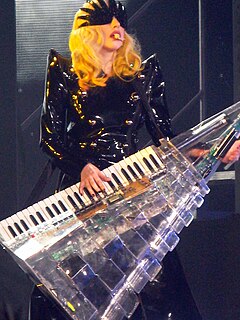
The keytar is a lightweight synthesizer that is supported by a strap around the neck and shoulders, similar to the way a guitar is supported by a strap. Keytars allow players a greater range of movement onstage, compared to conventional keyboards, which are placed on stationary stands or which are part of heavy, floor-mounted structures. The instrument has a musical keyboard for triggering musical notes and sounds. Various controls are placed on the instrument's "neck", including those for pitch bends, vibrato, portamento, and sustain.

The term squeezebox is a colloquial expression referring to any musical instrument of the general class of hand-held bellows-driven free reed aerophones such as the accordion and the concertina. The term is so applied because such instruments are generally in the shape of a rectangular prism or box, and the bellows is operated by squeezing in and drawing out.

The garmon, is a kind of Russian button accordion, a free-reed wind instrument. A garmon has two rows of buttons on the right side, which play the notes of a diatonic scale, and at least two rows of buttons on the left side, which play the primary chords in the key of the instrument as well as its relative harmonic minor key. Many instruments have additional right-hand buttons with useful accidental notes, additional left-hand chords for playing in related keys, and a row of free-bass buttons, to facilitate playing of bass melodies.

A piano accordion is an accordion equipped with a right-hand keyboard similar to a piano or organ. Its acoustic mechanism is more that of an organ than a piano, as they are both aerophones, but the term "piano accordion"—coined by Guido Deiro in 1910—has remained the popular name. It may be equipped with any of the available systems for the left-hand manual.

The pump organ is a type of free-reed organ that generates sound as air flows past a vibrating piece of thin metal in a frame. The piece of metal is called a reed. Specific types of pump organ include the reed organ, harmonium, and melodeon. The idea for the free reed was imported from China through Russia after 1750, and the first Western free-reed instrument was made in 1780 in Denmark.
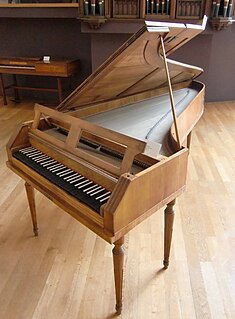
Johann (Georg) Andreas Stein, was an outstanding German maker of keyboard instruments, a central figure in the history of the piano. He was primarily responsible for the design of the so-called German hammer action. Pianos with this hammer action, or its more developed form known as the Viennese action, may be said to be appropriate for the performance of the piano music of Haydn, Mozart, and the early Beethoven.

Chord organ is a kind of home organ that has a single short keyboard and a set of chord buttons, enabling the musician to play a melody or lead with one hand and accompanying chords with the other, like the accordion with a set of chord buttons which was originated from a patent by Cyrill Demian in 1829, etc.
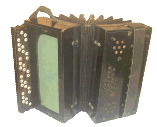
A Schrammel accordion is an accordion with a melody keyboard in the chromatic B-Griff system and a twelve-button diatonic bass keyboard. It is named for a traditional combination of two violins, accordion or clarinet, and contraguitar known as a Schrammelquartet – a group that played Schrammelmusik in the Vienna chamber music tradition.

The physharmonica is a keyboard instrument fitted with free reeds, a kind of harmonium much used in Germany in the early 20th century.
Georg Anton Reinlein was a musical clock maker in Vienna. A patent was granted to him in the year of 1824 for improving of the Hand harmonica (Physharmonica). The Instrument had free reeds of Chinese manner and bellows that were hand operated.

Christian Friedrich Ludwig Buschmann was a German musical instrument maker, often credited with inventing the harmonica and also the accordion.

Arthur Quentin de Gromard (1821–1896) was a French musician.

Gabriel Anton Walter was a builder of pianos. The Grove Dictionary of Music and Musicians describes him as "the most famous Viennese piano maker of his time".

The terpodion or uranion is a keyboard instrument which produces sound using the same friction principle as the glass harmonica.
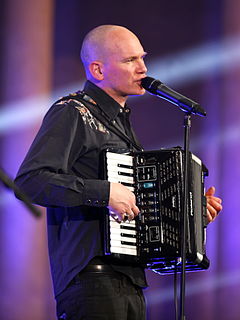
A digital accordion is an electronic musical instrument that uses the control features of a traditional accordion to trigger a digital sound module that produces a synthesized or digitally sampled accordion sounds or, in most instruments, a range of non-accordion sounds, such as orchestral instruments, pipe organ, piano, guitar, and so on. Digital accordions typically encode and transmit key presses and other input as Musical Instrument Digital Interface (MIDI) messages. Most digital accordions need to be plugged into a keyboard amplifier or PA system to hear their sounds.